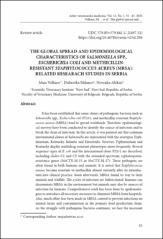| dc.contributor.author | Velhner, Maja | |
| dc.contributor.author | Milanov, Dubravka | |
| dc.contributor.author | Aleksić, Nevenka | |
| dc.date.accessioned | 2022-09-27T07:25:22Z | |
| dc.date.available | 2022-09-27T07:25:22Z | |
| dc.date.issued | 2022 | |
| dc.identifier.issn | 1820-9955 | |
| dc.identifier.uri | https://repo.niv.ns.ac.rs/xmlui/handle/123456789/551 | |
| dc.description.abstract | It has been established that some clones of pathogenic bacteria such as
Salmonella spp., Escherichia coli ST131, and methicillin-resistant Staphylococcus
aureus (MRSA) tend to spread worldwide. Th erefore, epidemiological
surveys have been conducted to identify the source of infection and to
break the chain of infection. In this article, it was pointed out that common
international clones of Salmonella are represented with the serotypes Typhimurium,
Kentucky, Infantis and Enteritidis. Serovars Typhimurium and
Kentucky display multidrug-resistant phenotypes more frequently. Several
sequence types of E. coli and the international clone ST131 are described,
including clades C1 and C2 with the extended-spectrum cephalosporinresistance
genes (blaCTX-M-15 or blaCTX-M-27). Th ese pathogens are
oft en found in both humans and animals. It is noted that Staphylococcus
aureus became resistant to methicillin almost instantly aft er its introduction
into clinical practice. Soon aft erwards, MRSA found its way to farm
animals and wildlife. Th e cycles of infection are bidirectional: humans can
disseminate MRSA in the environment but animals may also be sources of
infection for humans. Comprehensive work has been done by epidemiologists
to introduce all necessary measures to eliminate MRSA from hospitals.
Also, much eff ort has been made in MRSA control to prevent infections on
animal farms and contamination in the primary food production chain.
As the struggle with pathogenic bacteria continues, we face the incessantthreat of new resistance and virulence mechanisms, which bacteria use to
resist the hostile environment and enhance their survival in their natural
habitats including humans and animals. Th erefore, the capacity of certain
bacteria to spread due to their virulence mechanisms and resistance phenotypes
is presented, and a brief description of the research conducted in
Serbia is included. | en_US |
| dc.description.sponsorship | Th e research was funded by the grant from the Ministry of Education, Science
and Technological Development of the Republic of Serbia, by the Contract
of implementation and fi nancing of research work of NIV-NS, Contract
No.451-03-68/2022-14/200031. | en_US |
| dc.language.iso | en | en_US |
| dc.publisher | Scientific Veterinary Institute „Novi Sad“, Novi Sad, Serbia | en_US |
| dc.source | Arhiv veterinarske medicine / Archives of veterinary medicine | sr |
| dc.subject | Salmonella | en_US |
| dc.subject | E. coli | en_US |
| dc.subject | MRSA | en_US |
| dc.subject | virulence | en_US |
| dc.subject | epidemiology | en_US |
| dc.subject | clonal spread | en_US |
| dc.title | The global spread and epidemiological characteristics of Salmonella spp., Escherichia coli and methicillin-resistant Staphylococcus aureus (MRSA): related researach studies in Serbia | en_US |
| dc.title.alternative | Globalna rasprostranjenost i epidemiološke karakteristike pojedinih klonova Salmonella spp., Escherichia coli i meticilin rezistententnih Staphylococcus aureus (MRSA) i prikaz sličnih istraživanja u Srbiji | en_US |
| dc.type | Article | en_US |
| dc.identifier.doi | 10.46784/eavm.v15i1.294 | |

